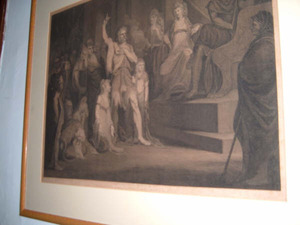The ‘Real' Caratacus - A brief overview
Caratacus. Caractacus. Caradoc. Caradog. The names conceal a man of many identities. There is the Welsh hero of myth and legend, and there is the historical warrior prince, son of the powerful Cunobelinus, king of the Catuvellauni and the Trinovantes, tribes which originated in and around Essex and Hertfordshire, forming a territory north of the River Thames which stretched from the Chiltern Hills in the west to the Tendring Peninsula in the east..
Historically, When Cunobelinus's eldest son, Togodumnus succeeded his powerful father's long and successful reign, some time before the Roman invasion of AD 43, Caratacus, already showing signs of being a capable and resourceful leader began to carve out a kingdom for himself south of the Thames. It is possible to see signs of the extent of his influence from the discovery of coins bearing his head. It appears he also at this time began to forge useful alliances with his southern and western neighbours.
The third son of Cunobelinus, Adminius, bitter at not being included in what he saw as a fair share out of his father's lands, helped instigate the Roman invasion by appealing to the Roman emperor, Caligula, for help against his brothers. This appeal , while not acted on at once, was followed some time later by another to his successor, the emperor Claudius, by King Verica of the Atrebates, perhaps, ironically, driven to so by Caratacus's invasion of his territories. Claudius was persuaded that an invasion of these rich and quarrelsome islands was overdue and eager to divert attention at home from a difficult political situation he began to plan his strategy.
Togodumnus and Caratacus led the opposition to the invasion but Togodumnus died or was killed as the Roman forces surged north across the Medway and the Thames, leaving his brother Caratacus to lead the opposition alone. Defeat was almost certain, but at this point Plautius, the leader of the Roman army was forced to pause in his attack on Caratacus's capital, Camulodunon, which later under the Romans became Camulodunum, to await the arrival of his emperor who wanted to lead his army to triumph in person. This gave Caratacus the chance to withdraw and regroup his troops, and allowed him to take the centre of the opposition to Rome westwards. His final defeat did not come until AD 50. His flight to seek aid from the Celtic queen, Cartimandua of the Brigantes, her actions, as a client of Rome in handing him over to the Roman army and his transfer with his surviving family to Rome are all recorded by the Roman historians, (and me, in Daughters of Fire!) at which point the historical record moves back to Britannia to follow the further opposition of the western tribes to their Roman overlords.

'Caractacus at the Tribunal of Claudius in Rome by Fuseli, engraved by
Andrew Birrell. An inexpert photo, I'm afraid, but it gives you the general idea of the nobel savage!'
The Other Caratacus
The other Caratacus is a focus of many myths and legends rather in the same way King Arthur, probably a Romano British war lord, became the centre of an entire body of quasi historical, poetic, legendary and mythical literature. In the case of Caratacus, the historical leader was increasingly adopted by medieval Welsh writing and probably conflated with at least one other king of similar name, and with legendary figures. In one story, for instance, in medieval Welsh literature, Caradog is the son of Bran, son of the god Llyr, a hero of Welsh and Irish myth, who after he lost his life in battle was decapitated by his followers so that his head could after adventures en route be taken to London and buried on Tower Hill to protect the nation. In another famous Welsh collection of stories, The Mabinogion, Caratacus is described as the son of ‘Bran the Blessed'. This Bran in a Christian version of the story was credited with marrying Anna, daughter of Joseph of Arimathaea and in this version Caratacus was already a Christian before he went to Rome. There are few mentions of Caratacus's's wife by name. Eurgain is one (also listed as a daughter ) and Euvrain and there are others which sound medieval rather than Celtic.
In Geoffrey of Monmouth's History of the kings of Britain there is, interestingly, no mention of Caratacus, but he mentions Arviragus who corresponds to Caratacus time-wise, and is listed as the son of Kymbelinus. Bede doesn't mention him at all. Shakespeare's Cymbeline interestingly doesn't mention him either.
Welsh antiquarian, scholar, and alas, forger, Iolo Morganwg asserted that Caratacus did indeed return from imprisonment in Rome and it was he who brought Christianity back to Britain
There are also stories in this category about the members of Caratacus's family who accompanied him to Rome. The historical record mentions only his wife and one daughter (and ‘brothers', but we don't know the names of any brothers beyond the three above mentioned). There is as far as I know only the one account of Eigon, which is local, and appears, as far as I know, no where else. There is also mention of Gladys, a younger daughter who was taken with them to Rome where she married the Roman senator Rufus Pudens, assuming the name of Claudia Rufina. Legend has it that the church of Santa Pudenzia in Rome was dedicated to her, and that the present building was the site of the Palatium Britannicum, once the home of Caratacus and his family. (The church if you want to see it is located on the Via Urbano.) Subsequent history shows a very different evolution of the name, but nevertheless the original building seems to date back to the first century.
According to these ancient traditions another of Caratacus's daughters became St Eurgen, Eurgan or Eurgain, married Salog, the ‘Lord of Salisbury', or Old Sarum, and founded a college of 12 Christian Druids at Caer Urgan or Llan Illtyd fawr&ldots;. On the other hand she could have been the 6th century daughter of another chieftain called Caradog&ldots; (But perhaps this name which is vaguely similar, could this be a memory of the daughter I have identified as Eigon? Fascinating!)
One of Caratacus's sons (or indeed grandsons) in yet another story, was Linus , the first (or second or third according to the version one consults) Bishop of Rome.
One of the books I read mentions ‘a certain amount of confusion' about all this, a description to which I heartily subscribe, while enjoying it all enormously. When writing an novel with such ancient setting one has to navigate one's way through many sources, both historical, pseudo historical and legendary. I chose to follow as nearly as I could the historical record about Caratacus and his family but as I was writing about Eigon, the story is hers. So, I did a little cherry picking for the rest! I named Caratacus's son Togo in my story after his dead brother as I felt he would have done; I used Gladys for Eigon's sister as this was a name which appeared in the Welsh legends. Linus I preferred to ignore for the purposes of this story. The Concise Oxford Dictionary of the Christian Church acknowledges that someone of that name was according to most lists, bishop of Rome after Peter and Paul, but then firmly adds ‘Nothing further is certainly known'.
Besides the myth and legend found in ancient and medieval texts there is some hair-raising stuff to be found on the net if you Google around any of these subjects! Judging by the amount of basic historical errors and appalling anachronisms incorporated into some of this material it is a free for all in the imaginary stakes.
But then , what is a novel...?





